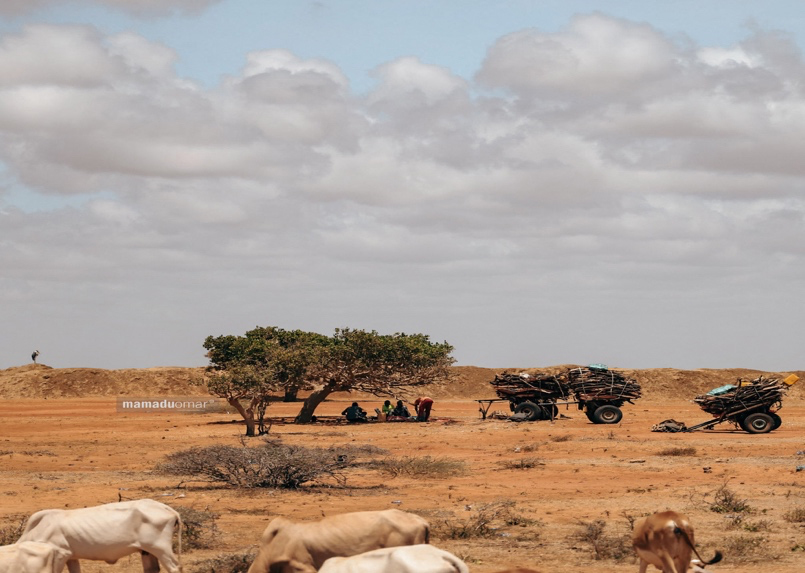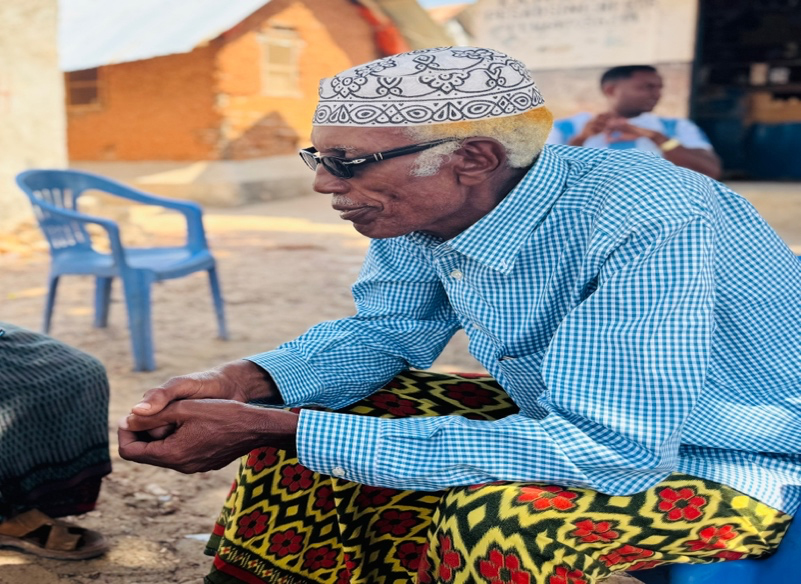The Price of Shade – A narrative of survival, loss, and the fading green heart of Somalia.
Men rest beneath a lone Garas tree after collecting firewood, finding momentary comfort in the same shade their labor slowly erodes. The image captures Somalia’s silent paradox of survival and loss.

Midday light falls harshly across the land, bleaching every color into dust. In the middle of the emptiness stands a single Garas tree, its branches twisted against the wind like an old guardian refusing to bow.
Beneath it, a group of men sits quietly beside a wooden cart stacked high with freshly cut firewood. The air smells of sap and dry soil.
They do not speak much. One pours water from a yellow jerrycan, the rest wait their turn. Sweat traces paths through the dust on their faces. Above them, the Garas stretches its tired limbs as if still willing to serve those who are slowly undoing its kind. For a moment, its shade feels like forgiveness.
Beyond the tree, the land lies stripped and restless. The horizon is marked by stumps where forests once softened the wind. The soil, loosened by neglect, drifts with every gust, whispering its slow retreat. Each fallen branch tells a quiet story of survival traded for scarcity, of a people wrestling between hunger and hope.
In this scene, comfort and guilt coexist. The men seek shade from the same tree whose fate they have sealed. They are not destroyers by choice but survivors of necessity. Every log in the cart is a meal, a school fee, a night of warmth. Yet each load also means one less tree to call the rain, one more patch of land exposed to the sun’s rage.
The Garas stands as witness to this uneasy bargain. Its shadow covers both the weary and the culpable, both mercy and consequence. As the men rest, the silence becomes a question the earth keeps asking: How long can we live from what we are killing?
When they leave, the breeze resumes its slow work of carrying away the soil. The tree remains, but lighter now, lonelier. The story of Somalia’s changing climate does not begin in distant conferences or data tables. It begins here, in the shade of a dying tree that still gives even as it fades. The first chapter in what we have come to call the price of shade.
The Vanishing Forest
The wind moved softly through belts of Qudhac, Garas, and Galool trees that held the soil firm and called the rain home. Streams curved between them like silver threads, and herders could walk for miles without meeting the naked glare of the sun. Those memories are now fragments carried by the old, spoken with a tone that sounds almost mythical to the young.
Today, that green silence has thinned to a whisper. Forests once seen as endless are now reduced to islands of shade surrounded by miles of emptiness. The trade in charcoal, the hunger for cooking fuel, and the simple struggle to survive have all taken their toll. Every tree felled lights a single meal but darkens the horizon for years to come.
The forest does not fall with noise; it disappears in absence. Birds that once woke villages at dawn have migrated elsewhere. The soil, stripped of its anchors, moves with the wind, forming dunes that bury roads, farms, and sometimes entire villages. Rivers dry before reaching their destination, and wells turn shallow and warm.
Abdullahi Ali, a man who lives in Kismayo Town under lower Juba said, “When the trees left, the rain forgot us.” His words echo the truth scientists now confirm the link between deforestation and the collapse of Somalia’s rain cycle. With each felled trunk, the sky loses its memory of when and where to pour. The clouds that used to gather faithfully now drift confused and reluctant.
This, in turn, begins a chain that touches everything including the farmer, the herder, the fisher, and the child waiting for a harvest that never comes. What begins as an axe in a forest ends as a famine in a household. What starts as a single fallen tree becomes a shifting dune burying homes in Hobyo, Kulub, and beyond.
The forest once protected life; now life has turned against it. The price of shade is no longer measured in logs or charcoal sacks but in seasons lost and futures uncertain. And yet, the land still waits, patient and wounded, for the day its children will plant again, when the silence of the forest might turn green once more.
The Broken Sky
Once, elders could read the wind, the scent of soil, and the shape of clouds to tell when the rains would come. The Gu season brought life, the Deyr restored hope, and the Hagaa heat carried its own quiet promise of renewal. Now, the sky no longer keeps its word.
The rains arrive as strangers, sometimes too heavy, sometimes not at all. Months of drought are followed by sudden floods that wash away what little has survived. Villages that prayed for rain now pray for mercy from it. The calendar of nature, once predictable and sacred, has become a riddle no one can solve.
In the interior, cracked riverbeds lie open like old scars. The Shabelle and Juba rivers, once `flowing with stories and songs, now shrink in silence, exposing stones that remember better days. Wells yield only mud, and women walk farther each morning to fetch water that tastes of salt and metal.

Bakari Mohamed, a fishermen elder from Chuvai Island in the Lower Juba region, watches the waves crash against the eroded shoreline where the sea he once depended on now encroaches on his home. His gaze reflects both memory and loss in a changing climate.
Photo courtesy: Birimo Consultancy.
On the coast, the sea itself feels different. Warmer waters have pushed fish farther from shore, leaving fishermen staring at empty nets. “The ocean breathes faster now,” says Bakari Mohamed, a fishermen elder from Chuvai Islandin the Middle Juba region, watching the tide crash against eroded sands. “Even the sea is thirsty.” He said.
From here, the chain continues. Crops wilt, herds collapse, and families scatter. The loss of trees has broken more than the soil; it has broken the covenant between the earth and the sky. Without forests to draw moisture, clouds pass Somalia as if it no longer belongs to the map of rain.
Each dry season grows longer, each flood more violent. Children born today may never know what a normal year feels like. The broken sky has become the new reality, silent, unpredictable, and cruelly honest.
And still, beneath this fickle heaven, people wait. They plant seeds in cracked earth, they whisper old prayers, and they look upward, hoping that one day the sky will remember them again.
The Empty Fields
Across Somalia’s once fertile plains, the fields lie silent. The wind moves where rivers once flowed, lifting the dust of abandoned farms into the air. The soil, stripped of its cover, has hardened into a crust that rejects both seed and promise. In the north, terraces have cracked like pottery. In the south, farmlands that once shimmered with green now carry the dull color of despair.
The most arable and fertile land that once stood as the pride of the Juba regions has fallen still. The gravity-fed irrigation systems of Jilib, Buale, Salagle, and Jamaame, which once formed the agricultural heart of Somalia, now lie dry and forgotten. The canals that once guided river water into plantations now carry nothing but dust and silence. Crops no longer rise from the soil that once fed a nation.
In Luglow, a small location on the outskirts of Kismayo, many of the same farmers who once brought food to Somali tables now live in displacement camps. Their hands still remember the rhythm of planting and harvest, but today they till the earth only to secure their tents. Among them is Nurto Ali, an elder farmer woman who once owned a flourishing farm in Jamaame. She looks toward the horizon and says, “The land that raised us now lies in silence, and we have become its refugees.” Her words carry the grief of a generation that watched abundance fade into memory.
When the rains fail, hunger does not wait. Cows die first, then goats, and finally hope. The pastoral routes once alive with herders and song now stretch across empty plains where bones glimmer under the sun. Families who depended on milk and meat for generations are left with nothing to trade and nothing to sell.
Along the coast, fishermen push their boats farther out each morning, chasing the memory of abundant waters. The sea that once fed them now grows warmer and more unpredictable. Storms arrive without warning, and the nets return lighter with every journey. Bakari Mohamed, the fishermen elder from Chuvai Island, says softly, “There are days when the ocean feels emptier than the land.”
The emptiness of the land does not stop at the fields. It travels to the markets where the cost of food rises beyond reach. It enters the homes where children cry quietly through the night. It reaches classrooms where teachers wait for students who have gone to fetch water instead of learning.
From here, the chain continues. The loss of trees has led to the loss of soil, which has led to the death of herds and the vanishing of fish. Each loss feeds another, creating a slow unraveling of life’s balance. Agriculture, livestock, and fisheries, the three pillars of rural survival, now lean against the weight of climate and neglect.
The Hungry Cities
The road to every Somali city begins with loss. It begins in dry fields, in empty troughs, and in the broken irrigation canals that no longer carry water. Families leave behind cracked walls, dead herds, and the silence of farms that can no longer grow anything. They walk toward cities carrying what they can on their backs, following the faint promise that somewhere ahead, life will begin again.
In every major town, the same story unfolds. Trucks arrive at dawn carrying families from drought-stricken regions. Mothers cradle children whose arms are too thin, while fathers sit quietly beside sacks of clothes and bundles of cooking pots. These are not strangers to work or hardship. They are farmers, herders, and fishers who once fed the nation. Now they arrive with nothing but their memories and the will to survive.
The outskirts of Mogadishu, Baidoa, Kismayo, Dhusamareeb, and Garowe have become cities of tents. Plastic shelters stretch as far as the eye can see, shimmering under the heat. Each camp holds thousands of people who once had homes of their own. They share stories of vanished rivers, of fields turned to ash, and of trees that once sheltered them from the sun. In these crowded spaces, life starts again but smaller, narrower, and always uncertain.
Inside the cities, the strain grows heavier each week. Markets overflow with people but not with food. Prices climb higher as supply shrinks, and wages remain trapped by scarcity. Water vendors now earn more than farmers once did. Hospitals are filled with cases of malnutrition, and schools overflow with displaced children who study under trees that may not stand for long. The cities breathe with the weight of a crisis that touches every neighborhood.
Aden Dekow, an elder in one of the Mogadishu camps says quietly, “The city gives us noise but no peace.” His words echo through the tents at night when the wind blows sand through the alleys. The same wind that once swept through farms now sweeps through displacement camps, carrying the dust of lost dignity.
Nurto Ali, the farmer from Luglow, watches her children play near a water tap surrounded by jerrycans. She says softly, “In the village, hunger was shared. In the city, it is silent.” Her voice captures the quiet transformation of Somalia’s hunger, from the open struggle of rural drought to the crowded invisibility of urban displacement.
This movement from the countryside to the cities is more than migration. It is a reshaping of identity. Generations raised on the rhythm of planting and herding now live by the rhythm of aid distribution. Children born in camps grow up knowing tents as home and food rations as harvest. The bond between people and land weakens a little more with each passing season.
Somalia’s urban centers now mirror the emptiness of the land. The hunger that once stalked the villages has moved into the cities, turning market streets and camp corridors into lines of waiting. Each new arrival deepens the strain on fragile services, blurring the line between temporary refuge and permanent survival.
The hungry cities are not only a symptom of drought and deforestation but also a mirror reflecting choices made over decades. They remind the nation that when trees fall unchecked, when soil is left bare, and when water is allowed to vanish, the consequences do not stop in the countryside. They follow the people into the cities, into the markets, and into the homes.



